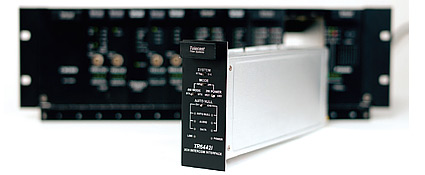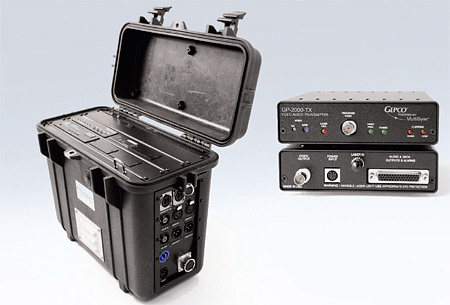Making the Right Connections
NEW YORK: Connectors and cable, copper and fiber, these form the necessary threads that tie gear together to create functional audio, video, communications, and control systems.
Far from being the same old thing, each year the industry sees more and more innovations in this product area.
FIBER
Telecast Fiber recently introduced the 6442i CommLink fiber-optic intercom link. While the Worcester, Mass.-based company has incorporated intercom into its Adder II system along with audio and data, CommLink is "a device designed to simply move only intercom over fiber," said Jim Hurwitz, director of product management and marketing. "It's more economical. It accepts any of the industry standard communications systems and moves two channels of intercom audio bi-directionally and two channels of bi-directional data on a single strand of fiber."

Telecast Fiber 6442i CommLink fiber-optic intercom link CommLink interfaces with Clear-Com and RTS TW party line (two-wire) systems, and Clear-Com MatrixPlus/Eclipse and RTS Adam/Cronus/Zeus digital matrix four-wire systems. Data is RS422 and RS485, to accommodate either of these comms systems, each having its own way of handling voice and data.
A two-channel system consists of two CommLink modules, one connected to the matrix or party line system, like in a truck, and the other at a remote location. The two modules are connected with one strand of single mode fiber.
Fiber-optic usage and applications continue to grow, and while fiber offers immunity to RFI/EMI interference, lighter cable weight, and long distance transmission, it does require a certain amount of care and feeding.
"Making the servicing of fiber systems easier, like field repair, cleaning and polishing, without requiring expensive equipment and training is a concern," said Mark Boyadjian, Neutrik Marketing and Communications Manager for Neutrik in Charlotte, NC. "The benefits of fiber can be overshadowed by these factors, resulting in a copper solution being selected only because it is a known quantity with a high comfort level."
Boyadjian says that Neutrik's opticalCON fiber-optic system "meets the continuing need for ruggedized signal transmission via fiber without the expense or overbuilding of a military fiber-optic connection. The opticalCON design is easy to clean, always dirt and dust protected, and field repairable." The opticalCON DUO two-fiber system features automatic shutters to cover the fiber ends in the unmated condition, an all-metal housing to protect the LC terminations, longer gold plated copper contacts with added insulation for use with a broader range of in-studio cameras, and rodent/cut resistant jackets."

Gepco has partnered with MultiDyne for the "Gepco Powered by MultiDyne" line of fiber-optic transport products, including the LiGH TBoX Weather-Tight Portable Fiber Field Acquisition System and GP-2000. Gepco has developed the V-Light Active Fiber Cable System which, according to Paul Scott, Gepco Application Engineering Specialist, combines copper connections, without the hassle of keeping fiber-optic connections clean. "Based on Gepco's V-CON connector, the V-Light connector eliminates concerns of optical debris or poor mechanical mating from connector wear," Scott said. "Inside each weather-tight and rugged V-Light connector shell, the fiber is sealed and isolated, while the electrical signal is converted to an optical one, or vice versa."
Gepco has also partnered with MultiDyne Video & Fiber Optic Systems to launch the "Gepco Powered by MultiDyne" line of fiber-optic transport products, including the LiGHTBoX Weather-Tight Portable Fiber Field Acquisition System, GP-2000, GP-2500 and the GP-GE1000.
COPPER
Innovations in copper abound as well.
"We are producing cable that we couldn't have produced 10 years ago," said Steve Lampen, multimedia technology manager and product line manager for Belden Cable in Richmond, Ind. "The machines are run by computer and the dimensions of the video cable are taken by a laser micrometer a thousand times a second."
Case in point is the Belden 1694A coax cable now rated for 4.5 GHz video, although older cable labeled 3 GHz has always met the new rating.
With more digital audio over coax and the continuing need for a mechanical backup of an electrical A/V router, "patchbays are not going away," said Mike Buchanan, vice president of Bittree in Glendale, Calf. In fact they are getting denser.
Bittree is coming out with a 2x48 coax panel with a DIN coax panel connector. "The form factor is one or one and a half rack units with large designation strips and a handy cable management tie bar on the rear," Buchanan said.
The DIN connector, Buchanan said, is a push-pull type connector that makes it easier to install and remove. "The outside of the connector slides back and releases the connector from the jack," he said.
Category type cable is already being deployed for some A/V systems, but it has its limitations. The original 802.1Ethernet standard is currently being re-written to make it easier to carry video and audio on Ethernet. The new standard is 802.1BA—Audio Video Bridging (AVB) Systems "AVB technology is revolutionizing broadcasting, and sad to say, historic legacy wire—coax for video, twisted pair for audio and mic cables—are all going to go away and turn into one great Ethernet network," Lampen said. "In the next six months or a year almost everybody will have products."
As can be expected, AVB systems will require higher bandwidth cable than the 100 MHz of CAT5E and CAT6.
"CAT6A has the biggest bandwidth, 10 GHz, is the most expensive, and the hardest to put it," Lampen said. A Belden CAT6A cable is 10GX32, and the company offers customers pre-terminated, tested and guaranteed CAT6A cables.
Even CAT6 takes special care. "Bittree makes it easy to do quality installations with training, good documentation and best practices," Buchanan said. "We have a tool that's easy to use and a connector that's easy to install."
Category type cable doesn't always have to be used for networking. "Most broadcasters know that CAT5E works fabulously well for audio," Lampen said. "It takes advantage of what we did for the networking guys, making the best twisted pair ever."
But perhaps customers don't need multiple twisted pairs in a bundle, only one. Lampen took that idea to Belden engineering. "They thought a one-pair data cable was one of the stupidest new products," he said. "But this is the lowest noise audio cable, and it's inexpensive. But it is unshielded so it can't run phantom power."
The cable—1353A, as it turned out, became a bestseller.
The professional video industry's #1 source for news, trends and product and tech information. Sign up below.
